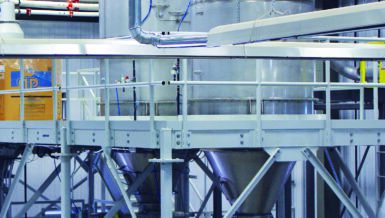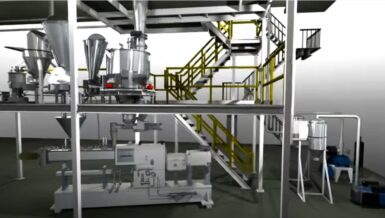While alternatives like nitrogen and argon are occasionally employed, the predominant use of air in pneumatic systems remains unmatched for its reliability. These systems propel materials through a continuous air or gas stream from hoppers or feeders, ensuring precise delivery to storage vessels or specific processing points. In today’s manufacturing landscape, pneumatic conveying is foundational, facilitating the efficient movement of vital materials essential for numerous operations.
Operating within pipelines, these systems expertly suspend and propel particles, showcasing versatility in transporting an extensive range of dry bulk materials, from fine powders to substantial granules and pellets. Enclosed within carefully designed structures, pneumatic systems substantially reduce material loss, contamination, and dust particle release, promoting environmental sustainability and a safer working environment.
However, despite their advantages, pneumatic conveying systems have inherent limitations. For instance, in dilute phase conveying, elevated velocities may cause chipping or fragmentation, which is particularly problematic for delicate or abrasive materials. Moreover, the interaction between the conveyed material and the pipeline in dilute phase conveying leads to gradual system wear and tear.
Energy consumption poses another challenge, demanding substantial energy due to high-pressure drops and rapid air velocities, necessitating consistent maintenance. Additionally, the operation of air movers can generate considerable noise, mandating noise reduction measures for a conducive working environment.
Differentiating between Dilute, Dense, and Semi-Dense Phase Conveying:
Pneumatic conveying broadly operates across three phases: dilute, dense, and semi-dense phase conveying.
Dilute-phase conveying involves high-velocity movement, suited for non-fragile materials due to its dispersed nature.
Dense-phase conveying, moving materials intentionally in a concentrated, slow manner, significantly minimizes material degradation, making it ideal for handling fragile or abrasive substances by using a higher material-to-air ratio.
Semi-dense conveying operates at a moderate velocity as a transitional phase positioned between the dense and dilute phases. In this phase, only a fraction of the materials is suspended within the airflow. Various sub-types cater to specific materials and conveying conditions within dense-phase pneumatic conveying.
For instance, full pipeline dense phase conveying, filling the entire pipeline, suits coarse, weighty, and non-abrasive substances, reducing degradation and wear.
Slug flow dense phase, transporting materials in packets, is suitable for conveying abrasive or fragile materials over shorter distances.
Bed flow dense phase employs wave-like motion, catering to less abrasive materials capable of compression.
Dilute phase pneumatic conveying, known for its high velocity and low pressure, effectively suspends materials within the airstream. It is best suited for non-abrasive, lightweight, and smaller-sized particles, especially beneficial for longer conveying distances.
Understanding Particle Transformation Mechanisms
In the complexity of pneumatic conveying, various particle transformation mechanisms play vital roles in particle evolution.
Attrition gradually reduces particle size due to recurrent impacts and forces inherent in pneumatic conveying.
Abrasion reshapes particles through frictional interactions, contributing to measurable wear over time.
Fragmentation coordinates the fracture of larger particles into smaller ones, especially evident when handling fragile materials.
Particle chipping detaches minute fragments, significantly influencing particle size distribution and enabling precise characterization.
These transformation mechanisms offer invaluable insights, shaping particle dimensions and impacting the conveyed product’s quality and characteristics, providing essential data for optimization and quality assurance in industrial processes.
Determining Powder Breakage:
Estimating the breakage of a powder involves comprehensive characterization by comparing the Particle Size Distribution (PSD) before and after transportation.
This comparison can be achieved through simple sieving or more precise methods like laser diffraction. However, in industrial settings, a rapid estimation of the impact of transportation on solid materials can be conducted by measuring the bulk density – tapped – before and after transport. A higher increase in bulk density signifies greater breakage.
How to Reduce Particle Breakage in Pneumatic Conveying
Estimating breakage in pneumatic conveying systems isn’t straightforward and typically requires trials to assess its impact.
The attrition, a direct consequence of solids impacting the conveying pipe, can be managed by implementing specific measures:
- Reduce Conveying Velocity: Minimizing conveying velocity and confirming it via pilot plant trials is crucial during design stages. Existing installations often operate at velocities far above optimal levels. If the blower operates on a Variable Frequency Drive (VFD), gradual adjustments to the airflow can be made while observing the system’s behavior to find the optimum velocity.
- The conveying velocity significantly affects particle breakage and pipe wear. A commonly used general relation model relates particle erosion in the pipe to particle velocity through the equation: Erosion = k.(particle velocity)n.
- Switch to Dense Phase Conveying: Consider transitioning to dense phase conveying, which generally operates at lower air conveying velocities than dilute phase systems.
- Minimize Bends: Bends in the pipeline contribute substantially to product breakage. Reducing the number of bends in the design phase can significantly reduce product damage. Sometimes, opting for a longer pipe layout with fewer bends proves more efficient than a shorter but bend-heavy layout.
- Optimize Bend Design: Certain bend designs can mitigate impact forces and breakage. Long-radius bends offer a solution, while designs facilitating a softer impact by creating a layer of product within the bend can also effectively minimize breakage.
It’s important to note that particle degradation might coincide with pipe wear, particularly due to particle impact on bends. Managing particle breakage is crucial for preserving product integrity and reducing pipe wear and system maintenance needs.













